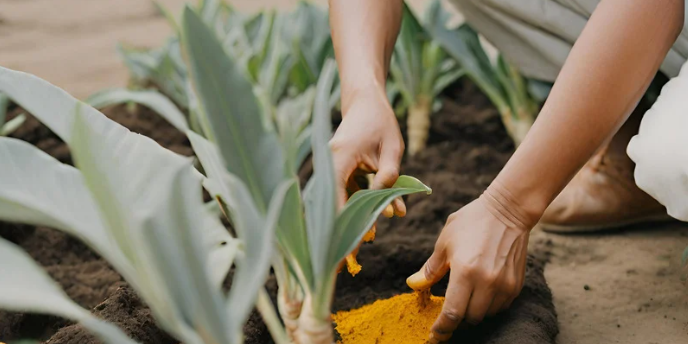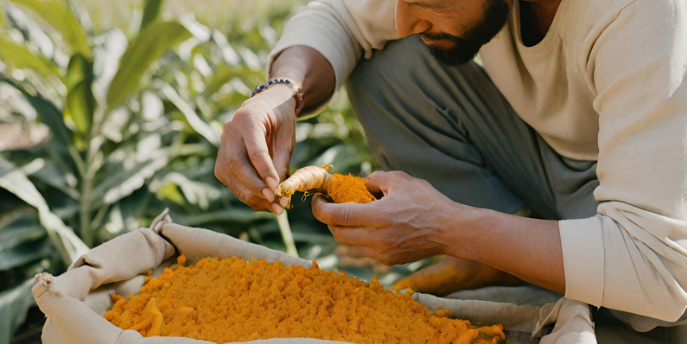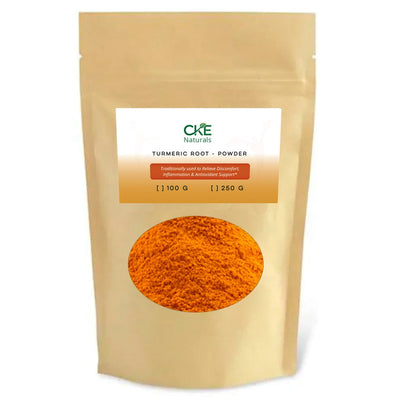How to Grow Turmeric Root at Home (Full Guide)
Turmeric, with its golden hue and earthy flavor, is not only an essential spice in many cuisines, but it's also a potent medicinal herb. Fortunately, you don't need a vast farm or advanced gardening skills to cultivate turmeric at home.
Here's a detailed guide on how to grow turmeric in your backyard or even indoors.
The Magnificence of Turmeric
Turmeric is a magnificent herb with a rich history and myriad applications. Let's explore its cultural significance, traditional uses, and the latest scientific discoveries about its health benefits to truly appreciate its splendor.
Turmeric's cultural significance extends beyond its culinary and medicinal value. It has deep roots in Southeast Asian culture and is a symbol of purity, prosperity, and spirituality. In Indian weddings, turmeric paste is applied to the bride and groom to purify and bless them.
In traditional medicine, turmeric root extract has been used for centuries to address various health concerns. Ayurveda, the ancient Indian system of medicine, has revered turmeric for its remarkable healing properties. It's used in cooking and multiple formulations for skin conditions respiratory ailments, and promoting overall well-being.
Recent scientific studies have shed light on the potential health benefits of turmeric. This is primarily attributed to curcumin, the active compound in turmeric. Curcumin is known for its potent anti-inflammatory and antioxidant properties, which have garnered significant attention from researchers. It's also being studied for its potential anti-cancer effects.
Procuring the Right Rhizomes

Selecting the right rhizomes is critical in ensuring a successful turmeric cultivation journey. Let's delve deeper into the factors to consider and the process of sourcing high-quality rhizomes.
The importance of sourcing high-quality rhizomes cannot be overstated. Rhizomes serve as the foundation for your turmeric plants, and their quality can significantly impact the overall success of your cultivation. To ensure you're making the right choice, let's explore how to select the best rhizomes in more detail.
When selecting rhizomes, look for plump, firm pieces with multiple buds or "eyes." These sprouts are the growth points, and it's ideal for each rhizome to have two to three buds. Freshness is paramount, and any mold, softness, or shriveling signs should be carefully avoided. While turmeric rhizomes may resemble ginger, their characteristic orange hue, when sliced open, distinguishes them.
In addition to local sources, online platforms can be a valuable option for procuring rhizomes. This ensures that you receive healthy and viable rhizomes for your turmeric cultivation.
Crafting the Perfect Bed

Creating the perfect soil bed for your turmeric plants is crucial for their growth and development. Let's go into more detail about the soil preparation process and the specific requirements for turmeric.
Turmeric is a tropical plant that thrives in environments characterized by warmth, moisture, and well-draining soil. Preparing the soil bed is a pivotal step in providing the best possible conditions for your turmeric. Whether you choose garden soil or a potting mix, specific steps need to be followed to ensure the ideal environment.
For those using garden soil, testing the pH is an important consideration. Turmeric prefers slightly acidic to neutral soil, with the ideal pH range between 6.0 and 7.5.
Given turmeric's lengthy growth cycle, it's advisable to incorporate a slow-release organic fertilizer at this stage.
If you're planting turmeric in containers, pots should be at least 12 inches deep to allow ample space for root growth. Furthermore, proper drainage is essential to prevent waterlogged conditions, as turmeric plants are intolerant of excess moisture.
The Planting Process

The planting process is a crucial phase in your turmeric cultivation journey. Let's dive deeper into the techniques and best practices for planting your carefully selected rhizomes.
Planting turmeric at the right time and in the right way is essential for its successful growth. While turmeric is forgiving in its growth requirements, some techniques can optimize its development.
The ideal time to plant turmeric is during the spring season. This ensures that the rhizomes have the entire warm growing season to flourish.
When placing the rhizomes in the soil, it's important to position them with the buds facing upwards. We can explain how these growth points reach towards the sun and give rise to the sprouts, which later evolve into the plant's stems and leaves.
Watering is crucial after planting, but maintaining consistent moisture levels without allowing the soil to become waterlogged is key.
Turmeric TLC (Tender Loving Care)

Caring for your turmeric plant is an art that requires attention and diligence. Let's explore in greater detail how to provide the best care for your turmeric, including watering, fertilizing, and pest management.
While turmeric isn't particularly demanding when it comes to nutrition, it does appreciate periodic nutrient boosts. Applying an organic liquid fertilizer every couple of months can help ensure balanced growth.
It's important to keep an eye on the leaves of your turmeric plants. If they start yellowing prematurely, it might indicate a nutrient deficiency, typically a lack of nitrogen.
Regarding pests, turmeric is generally resistant, but regular checks are wise, especially under the leaves. We should expand on the common pests that might affect turmeric and discuss organic pest control solutions to protect your plant's health. This includes methods for preventing and managing aphids and whiteflies, which can occasionally pose a threat to turmeric plants.
The Harvesting Hymn

Harvesting your homegrown turmeric is a moment of great satisfaction. Let's delve deeper into the details of the harvesting process, including the signs that indicate it's time to harvest and the best practices for harvesting without damaging the rhizomes.
Harvesting typically occurs 8-10 months after the initial planting, but the exact timing may vary depending on the variety and specific growth conditions.
The harvesting process itself should be explained in detail. Using a gentle hand or a gardening fork to excavate around the base of the plant carefully is crucial. We can provide step-by-step instructions for this process to ensure that you avoid damaging the delicate rhizomes.
You'll discover beneath the soil a cluster of golden rhizomes interconnected by a web of roots. The experience of unearthing your homegrown turmeric is profoundly satisfying, representing the culmination of months of care, patience, and effort.
Post-Harvest Protocol

After the joy of harvesting your turmeric, it's important to handle the harvested rhizomes properly. Let's explore how to clean, store, and utilize freshly harvested turmeric in more detail.
The first step is to gently wash the rhizomes under running water, ensuring that any soil residues are scrubbed off.
Depending on your needs, the rhizomes can be used fresh or stored for more extended periods. For drying, slicing the rhizomes thinly and placing them in a shaded yet airy spot is the key.
Once dried, you can store them in airtight containers or even grind them into fresh turmeric powder. This homemade powder offers a richer flavor than store-bought alternatives.
An alternative storage method is freezing. If you plan to use the turmeric in its raw form over several months, we can discuss the process of placing the rhizomes in zip-lock bags, ensuring that all air is expelled to prevent freezer burn.
Reveling in Homegrown Turmeric

There's a unique joy in using ingredients you've cultivated yourself. Homegrown turmeric is a testament to your patience and care.
When you cultivate your own turmeric, you have the assurance of its purity. Without the use of commercial pesticides or growth enhancers, what you consume is 100% natural and wholesome.
Let's explore the extensive list of health benefits associated with this versatile spice, presented in bullet points for clarity.
Anti-Inflammatory Properties
Curcumin, the active compound in turmeric, is renowned for its potent anti-inflammatory effects.
It may help alleviate symptoms of inflammatory conditions like arthritis, making it a natural remedy for joint pain and stiffness.
Antioxidant Power
Turmeric is a robust antioxidant, which means it can neutralize harmful free radicals in the body.
This property helps protect cells from oxidative damage and may play a role in preventing various chronic diseases.
Digestive Aid
Turmeric can promote healthy digestion by stimulating bile production and reducing symptoms of indigestion and bloating.
It may aid in preventing or alleviating digestive disorders, such as irritable bowel syndrome (IBS).
Supports Heart Health
Curcumin may help improve the function of the endothelium, the lining of blood vessels, which contributes to better cardiovascular health.
It can reduce risk factors for heart disease by improving cholesterol levels and reducing plaque buildup in arteries.
Brain Health and Cognitive Function
Some studies suggest that curcumin has the potential to enhance brain function and reduce the risk of neurodegenerative diseases like Alzheimer's.
It may increase brain levels of brain-derived neurotrophic factor (BDNF), a growth hormone that functions in the brain.
Anti-Cancer Effects
While more research is needed, curcumin shows promise in preventing and treating cancer. It can inhibit the growth of cancer cells and contribute to the programmed cell death of cancerous cells.
Its anti-inflammatory and antioxidant properties may also play a role in cancer prevention.
Pain Relief
Turmeric can be used as a natural pain reliever, particularly for chronic conditions.
It may reduce pain associated with conditions like osteoarthritis and rheumatoid arthritis.
Anti-Aging Benefits
As an antioxidant, turmeric can help combat signs of aging by protecting the skin from free radical damage.
It may contribute to a healthier and more youthful appearance.
Skin Health
Topical application of turmeric or using turmeric-based skincare products may help with conditions like acne and psoriasis.
Its anti-inflammatory properties can soothe irritated skin and promote an even complexion.
Weight Management
Curcumin may assist in weight management by promoting fat loss and reducing inflammation in fat tissues.
It can be a helpful addition to a balanced diet and exercise regimen.
Immune Support
Turmeric's immune-boosting properties can help the body fend off infections and illnesses.
It may enhance the overall resilience of the immune system.
Anti-Allergenic
Some individuals find relief from allergies and allergic reactions by consuming or applying turmeric.
Its anti-inflammatory nature may help alleviate allergy symptoms.
Detoxification Aid
Turmeric supports the liver in detoxifying the body by increasing the production of enzymes that break down and eliminate toxins.
It can promote overall liver health.
Anti-Depressant Properties
Emerging research suggests that curcumin may have potential as a natural antidepressant.
It may enhance serotonin and dopamine levels, which contribute to mood regulation.
Diabetes Management
Turmeric can help regulate blood sugar levels, making it beneficial for individuals with or at risk of diabetes.
It may improve insulin sensitivity and reduce the risk of diabetes-related complications.
Wound Healing
Topical application of turmeric may enhance wound healing and reduce the appearance of scars.
Its anti-inflammatory and antimicrobial properties contribute to this effect.
Respiratory Health
Turmeric's anti-inflammatory properties can provide relief from respiratory conditions like asthma and bronchitis.
It may alleviate symptoms and improve lung function.
Gut Health
Curcumin can support the growth of beneficial gut bacteria, contributing to a healthier gut microbiome.
A balanced gut microbiome is associated with numerous health benefits.
Stress Reduction
Some studies suggest that curcumin may help reduce stress and anxiety by modulating brain chemicals like serotonin and dopamine.
It can contribute to overall mental well-being.
Natural Antiseptic
Turmeric has antiseptic and antibacterial properties, making it a valuable ingredient in natural remedies for wounds and skin conditions.
It can inhibit the growth of harmful bacteria.
Incorporating turmeric into your diet or skincare routine can offer a wide array of health benefits, ranging from reduced inflammation to enhanced brain function. However, consulting with a healthcare professional before using turmeric as a treatment for specific medical conditions is essential.
Turmeric products for physical health and supplements are also available, but choosing high-quality products and following the recommended dosages for optimal results is important. Whether as a flavorful addition to your meals or as part of your daily wellness regimen, the health benefits of turmeric make it a spice worth embracing in your lifestyle.
For a quick and informative overview of the health benefits of turmeric, you can skip ahead to the summarized table below.
|
Health Benefit |
Turmeric's Advantages |
|
Antidepressant Properties |
- Potential natural antidepressant |
|
Diabetes Management |
- Regulates blood sugar |
|
Wound Healing |
- Enhances wound healing |
|
Respiratory Health |
- Relieves respiratory conditions |
|
Gut Health |
- Supports beneficial gut bacteria |
|
Stress Reduction |
- Reduces stress and anxiety |
|
Natural Antiseptic |
- Antiseptic and antibacterial properties |
|
Incorporating Turmeric |
- Offers various health benefits |
Conclusion
The journey of growing turmeric at home is a delightful challenge that beckons the passionate gardener in you. While it demands patience, the results are incredibly rewarding in terms of both volume and quality. Embracing this journey is about more than just adding flavor to your dishes; it's an opportunity to connect with nature, understand the nuances of growth, and reap the therapeutic benefits of this golden herb.
With a little effort, care, and time, you can yield a treasure trove of this radiant spice right in your backyard or balcony. Cultivating turmeric is a testament to the satisfaction of nurturing a plant from rhizome to harvest and the joys of enjoying its rich and vibrant flavors in your culinary creations.
Growing `turmeric is a journey worth embarking on, not just for its culinary rewards but for its profound sense of accomplishment and connection to nature. Whether you are a seasoned gardener or a novice, the process of cultivating turmeric is a testament to the marvels of nature and the gratification of self-sufficiency.
However, if you want to buy pure turmeric powder to benefit from its life-changing properties, CKE Naturals is your go-to place!
FAQs
Turmeric (Curcuma longa) is revered both as a culinary spice and a medicinal herb. Here's a concise guide on how to cultivate it at home:
Selecting Rhizomes: Start with fresh, healthy turmeric rhizomes. They should be firm with visible buds or eyes.
Ideal Location: Turmeric prefers indirect sunlight. For potted plants, choose locations with filtered sunlight; partial shade works best for garden beds.
Planting: Plant the rhizomes 2 inches deep, with buds facing up. Space them about 12-16 inches apart.
Watering: Turmeric requires moist, well-draining soil. Water regularly, but avoid over-saturation.
Fertilizing: Use organic compost or a balanced liquid fertilizer every month.
Pests and Diseases: Monitor for aphids and leaf spot. Natural insecticides and good gardening practices can help manage these issues.
Turmeric typically takes 8-10 months to mature. Harvesting signs:
Yellowing Leaves: As the plant matures, its leaves start turning yellow and dry up.
Checking Rhizomes: Gently unearth a small section. Mature rhizomes are brightly colored and easy to snap.
Turmeric, a native of Southeast Asia, has been cultivated for over 2,500 years. Ancient records showcase its importance in traditional medicine and cuisine, especially in India, Indonesia, and China.
Historically, turmeric's origin traces back to the Indian subcontinent. Today, India remains the largest producer, consumer, and exporter of turmeric, followed by countries like Indonesia, China, and Bangladesh.
Turmeric is celebrated for its earthy, peppery flavor with a hint of bitterness. In cooking:
Curries: It's a staple in curry powders, lending a golden hue and distinctive flavor.
Rice Dishes: It's added to rice for color and taste.
Beverages: Turmeric latte, or "Golden Milk," is a popular drink made with milk, turmeric, and spices.
Turmeric contains curcumin, which has potent anti-inflammatory and antioxidant properties. Some benefits:
Joint Health: May alleviate arthritis symptoms.
Digestive Health: This can aid in digestion and combat bloating.
Brain Function: Emerging studies hint at its role in supporting brain health.



